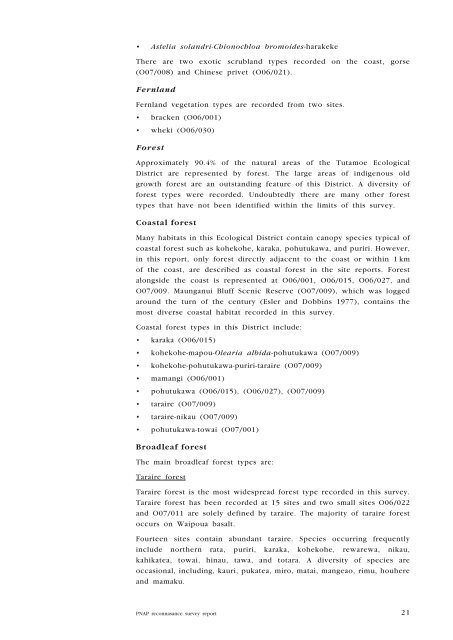Natural areas of Tutamoe Ecological District (3. Ecological character)
Natural areas of Tutamoe Ecological District (3. Ecological character)
Natural areas of Tutamoe Ecological District (3. Ecological character)
Create successful ePaper yourself
Turn your PDF publications into a flip-book with our unique Google optimized e-Paper software.
• Astelia solandri-Chionochloa<br />
bromoides-harakeke<br />
There are two exotic scrubland types recorded on the coast, gorse<br />
(O07/008) and Chinese privet (O06/021).<br />
Fernland<br />
Fernland vegetation types are recorded from two sites.<br />
• bracken (O06/001)<br />
• wheki (O06/030)<br />
Forest<br />
Approximately 90.4% <strong>of</strong> the natural <strong>areas</strong> <strong>of</strong> the <strong>Tutamoe</strong> <strong>Ecological</strong><br />
<strong>District</strong> are represented by forest. The large <strong>areas</strong> <strong>of</strong> indigenous old<br />
growth forest are an outstanding feature <strong>of</strong> this <strong>District</strong>. A diversity <strong>of</strong><br />
forest types were recorded. Undoubtedly there are many other forest<br />
types that have not been identified within the limits <strong>of</strong> this survey.<br />
Coastal forest<br />
Many habitats in this <strong>Ecological</strong> <strong>District</strong> contain canopy species typical <strong>of</strong><br />
coastal forest such as kohekohe, karaka, pohutukawa, and puriri. However,<br />
in this report, only forest directly adjacent to the coast or within 1 km<br />
<strong>of</strong> the coast, are described as coastal forest in the site reports. Forest<br />
alongside the coast is represented at O06/001, O06/015, O06/027, and<br />
O07/009. Maunganui Bluff Scenic Reserve (O07/009), which was logged<br />
around the turn <strong>of</strong> the century (Esler and Dobbins 1977), contains the<br />
most diverse coastal habitat recorded in this survey.<br />
Coastal forest types in this <strong>District</strong> include:<br />
• karaka (O06/015)<br />
• kohekohe-mapou-Olearia<br />
albida-pohutukawa (O07/009)<br />
• kohekohe-pohutukawa-puriri-taraire (O07/009)<br />
• mamangi (O06/001)<br />
• pohutukawa (O06/015), (O06/027), (O07/009)<br />
• taraire (O07/009)<br />
• taraire-nikau (O07/009)<br />
• pohutukawa-towai (O07/001)<br />
Broadleaf forest<br />
The main broadleaf forest types are:<br />
Taraire forest<br />
Taraire forest is the most widespread forest type recorded in this survey.<br />
Taraire forest has been recorded at 15 sites and two small sites O06/022<br />
and O07/011 are solely defined by taraire. The majority <strong>of</strong> taraire forest<br />
occurs on Waipoua basalt.<br />
Fourteen sites contain abundant taraire. Species occurring frequently<br />
include northern rata, puriri, karaka, kohekohe, rewarewa, nikau,<br />
kahikatea, towai, hinau, tawa, and totara. A diversity <strong>of</strong> species are<br />
occasional, including, kauri, pukatea, miro, matai, mangeao, rimu, houhere<br />
and mamaku.<br />
PNAP reconnasance survey report<br />
21

















